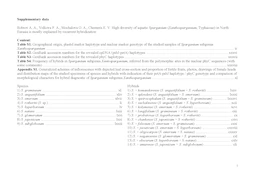Articles – High diversity of aquatic Sparganium (Xanthosparganium, Typhaceae) in North Eurasia is mostly explained by recurrent hybridization
1-s2.0-S1433831923000306-mmc1
Drag and drop files for uploading
 1-s2.0-S1433831923000306-mmc1
1-s2.0-S1433831923000306-mmc1High diversity of aquatic Sparganium (Xanthosparganium, Typhaceae) in North Eurasia is mostly explained by recurrent hybridization
Bobrov A. A., Volkova P. A., Mochalova O. A., Chemeris E. V.. High diversity of aquatic Sparganium (Xanthosparganium, Typhaceae) in North Eurasia is mostly explained by recurrent hybridization // Perspectives in Plant Ecology, Evolution and Systematics.. — 2023. — 60. — С. 1–26.
Аннотация:
The species composition and extent of hybridization in Sparganium subgenus Xanthosparganium in North Eurasia
reported in different published sources significantly vary. Thus, we aimed to clarify the taxonomy and distribution
of aquatic Sparganium in that area. We supplemented the existing fragmentary genetic and morphological
data mainly from North America and South Asia with our data from East Europe and North Asia. We combined
molecular barcoding of the nuclear phyC and plastid psbJ-petA DNA regions (382 samples) with morphological
analysis of herbarium collections (more than 1500 specimens from 16 herbaria) and numerous natural populations
with a special focus on hardly accessible Siberian and the Far Eastern regions of Russia. We found that
aquatic Sparganium is represented in North Eurasia by nine species and 14 hybrids. Nine previously unknown
hybrids are formally described as new nothotaxa. All species and hybrids could be reliably discriminated with
barcoding. We refined the distribution of all taxa in North Eurasia, e.g., S. angustifolium, a species avoiding
continental areas, where it was confused by many authors with mostly vegetative specimens of other taxa. In the
S. emersum complex in addition to recognized earlier widespread S. emersum and eastern North American S.
chlorocarpum we proved the existence of one more distinct lineage – Asian Pacific S. rothertii. We discovered
different evolutionary lineages within some species (e.g., S. glomeratum and S. hyperboreum) causing additional
issues in the taxa identification. Almost all species cross with each other, usually acting both as plastid and pollen
donors. Most of the hybrids are widespread and abundant. They originate each time when the ranges of parental
species overlap and suitable habitats are available, and rather do not disperse from the centres of origin. Hybridization
can be a threat to species with narrow ecological tolerance. Active gene flow is also evident within
species when different evolutionary lineages come in contact (e.g., S. emersum, S. rothertii, S. glomeratum,
S. hyperboreum, S. natans). We provide a new taxonomic treatment, which solves many long-standing issues in
subgenus
Edition: Perspectives in Plant Ecology, Evolution and Systematics.
Abstract in english:
Изучено распространение и видовой состав ежеголовников Sparganium подрод Xanthosparganium в Северной Евразии, выполнена таксономическая ревизия этой группы. Проведено молекулярное штрихкодирование ядерных phyC и пластидных psbj-petА участков ДНК (382 образца) в сочетании с морфологическим анализом гербарных коллекций (более 1500 образцов из 16 гербариев), также изучены многочисленные природные популяции из малоисследованных регионов Сибири и Дальнего Востока России. Наши результаты объединены с опубликованными генетическими и морфологическими данными по Sparganium из Северной Америки, Южной Азии и Европы.
В результате ревизии установлено, что Sparganium подрода Xanthosparganium представлен в Северной Евразии 9 видами и 14 гибридами. Девять ранее неизвестных гибридов описаны как новые нототаксоны.
Виды:
1 – S. gramineum, 2 – S. rothertii, 3 – S. glomeratum, 4 – S. hyperboreum, 5 – S. angustifolium, 6 – S. emersum (s. str.), 7 – S. natans, 8 – S. japonicum, 9 – S. subglobosum
Гибриды:
1 S. × komandorense A. A. Bobrov, Volkova, Mochalova et Chemeris nothosp. nov. (S. angustifolium × S. rothertii).
2 S. × splendens Meinsh. (S. angustifolium × S. emersum).
3 S. × speirocephalum Neuman (S. angustifolium × S. gramineum).
4 S. × sachalinense A. A. Bobrov, Volkova, Mochalova et Chemeris nothosp. nov. (S. angustifolium × S. hyperboreum
5 S. × kolymense A. A. Bobrov, Volkova, Mochalova et Chemeris nothosp. nov. (S. emersum × S. rothertii)
6 S. × longifolium Turcz. ex Ledeb. (S. gramineum × S. rothertii).
7 S. × probatovae Tzvel. (S. hyperboreum × S. rothertii).
8 S. × chankense A. A. Bobrov, Volkova, Mochalova et Chemeris nothosp. nov. (S. japonicum × S. rothertii).
9 S. × foliosum A. A. Bobrov, Volkova, Mochalova et Chemeris nothosp. nov. (S. emersum × S. gramineum).
10 S. × jacuticum A. A. Bobrov, Volkova, Mochalova et Chemeris nothosp. nov. (S. emersum × S. hyperboreum).
11 S. × oligocarpon Ångstr. (S. emersum × S. natans).
12 S. × naganoense A. A. Bobrov, Volkova, Mochalova et Chemeris nothosp. nov. (S. glomeratum × S. gramineum).
13 S. × obscurum A. A. Bobrov, Volkova, Mochalova et Chemeris nothosp. nov. (S. hyperboreum × S. natans).
14 S. × amurense A. A. Bobrov, Volkova, Mochalova et Chemeris nothosp. nov. (S. japonicum × S. subglobosum).
Все виды и гибриды могут быть различимы с помощью генетических методов, а при наличии генеративных побегов – по морфологическим признакам. Подготовлены ключи для определения, а также таблицы и иллюстративный материал (схемы соцветий, фотографии и гербарные образцы) для сопоставления морфологических признаков. Уточнено распространение всех таксонов в Северной Евразии.
Olga Mochalova, 28.02.2024 23:29